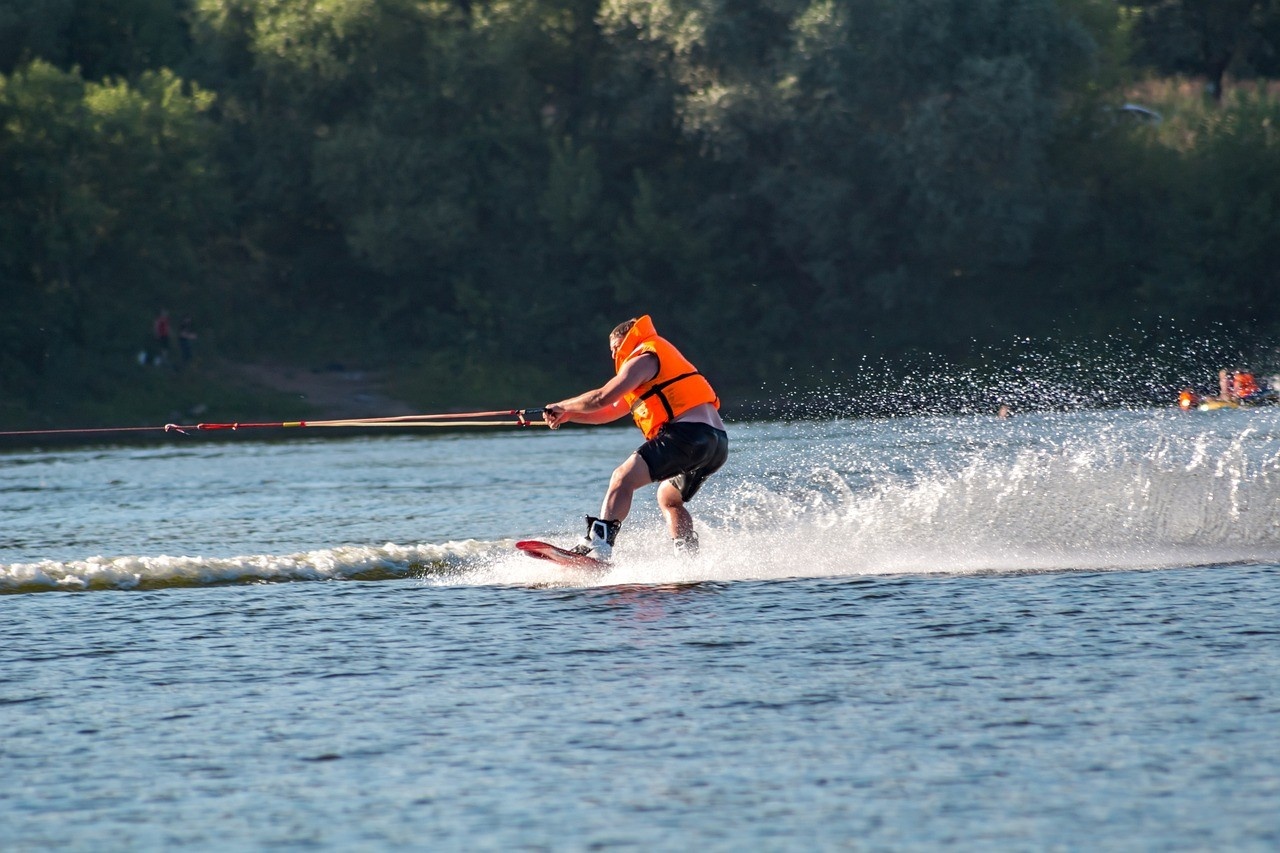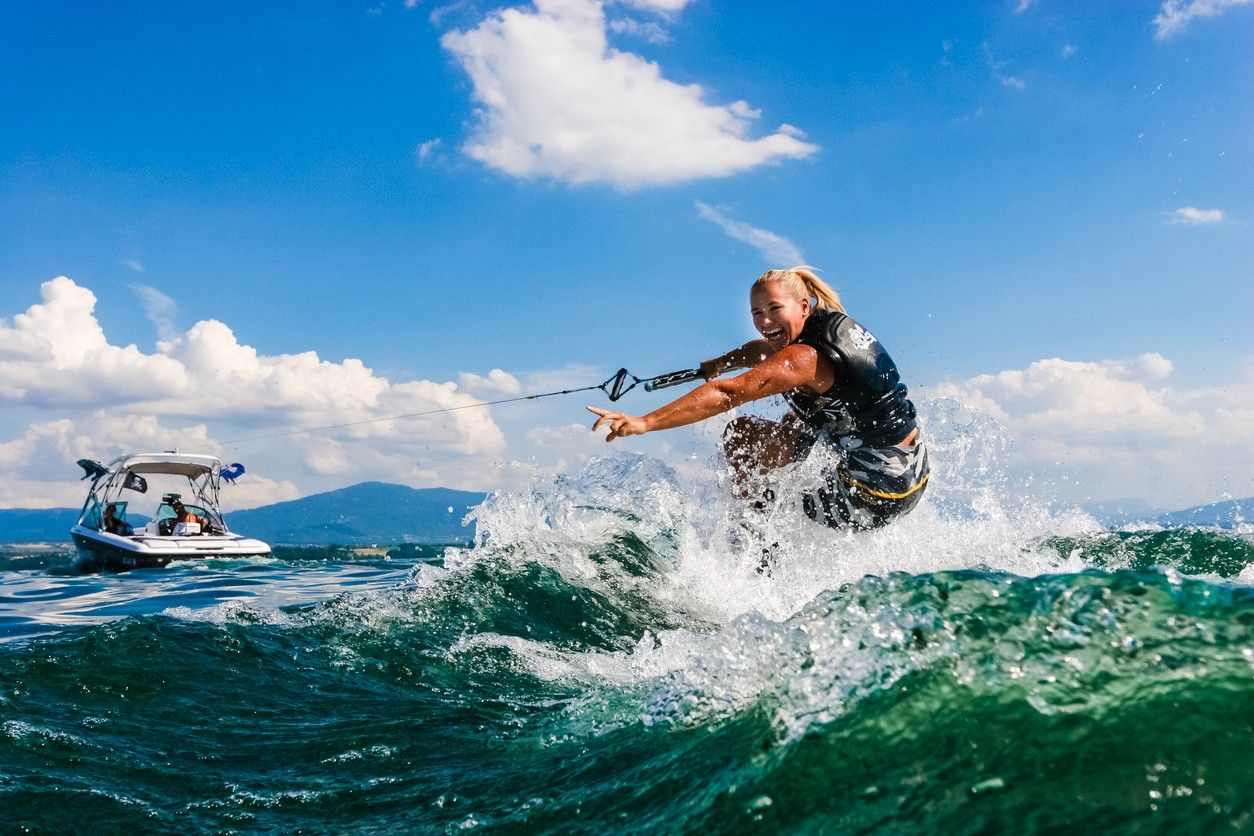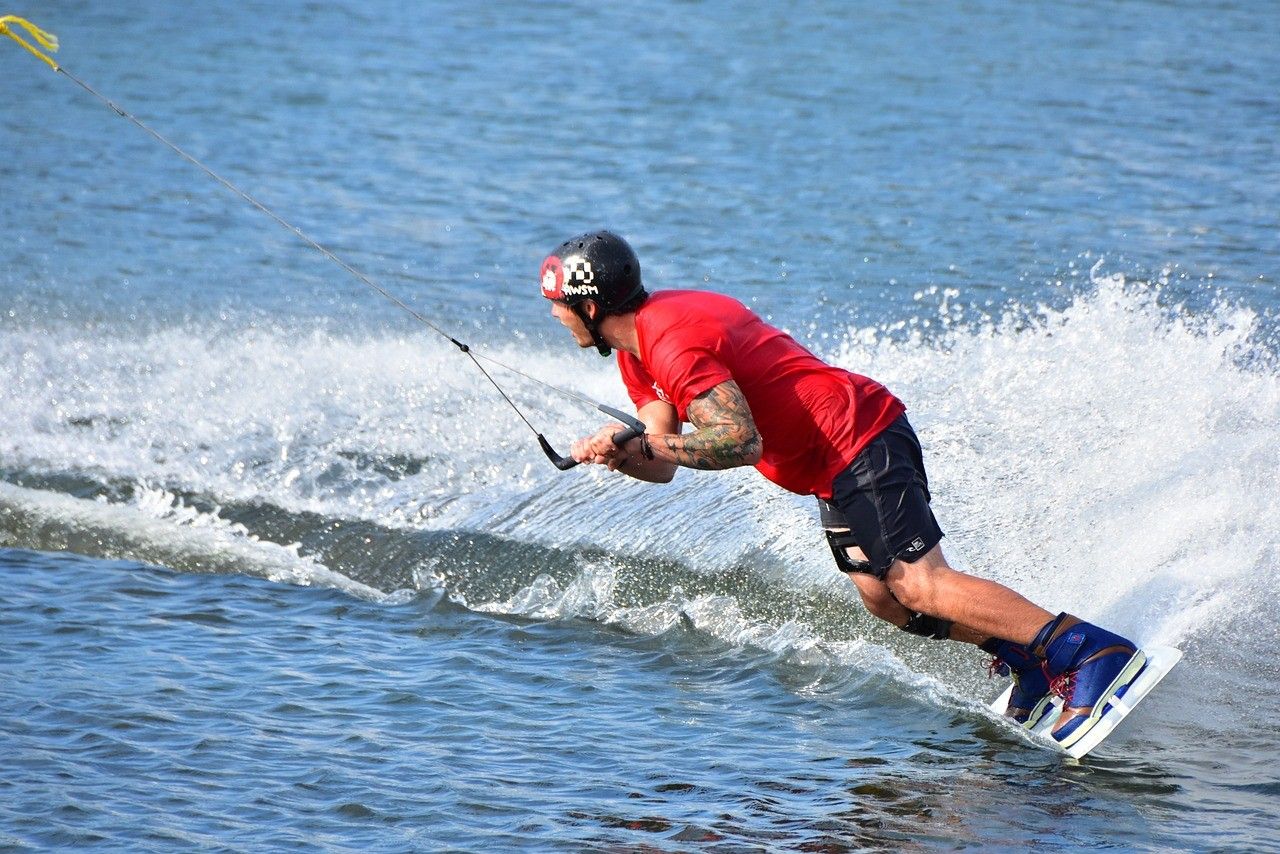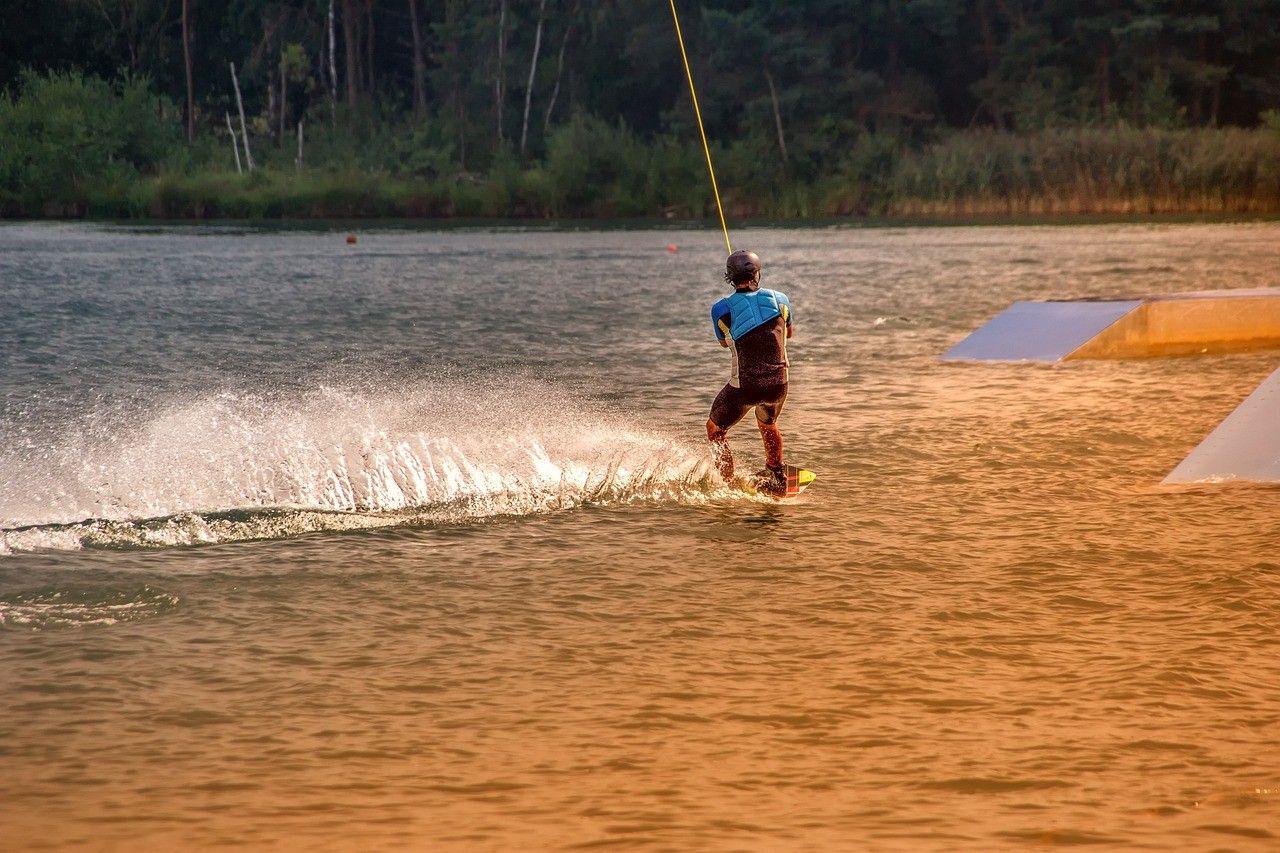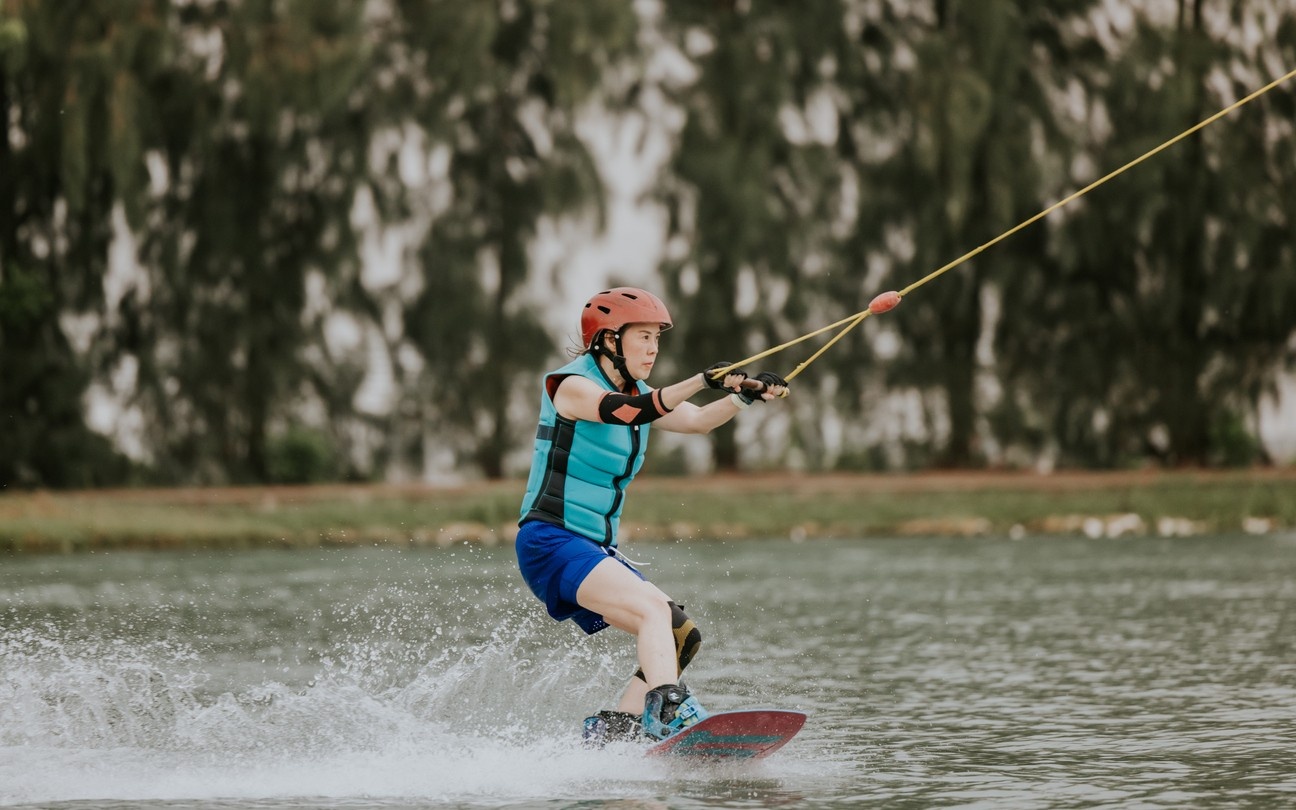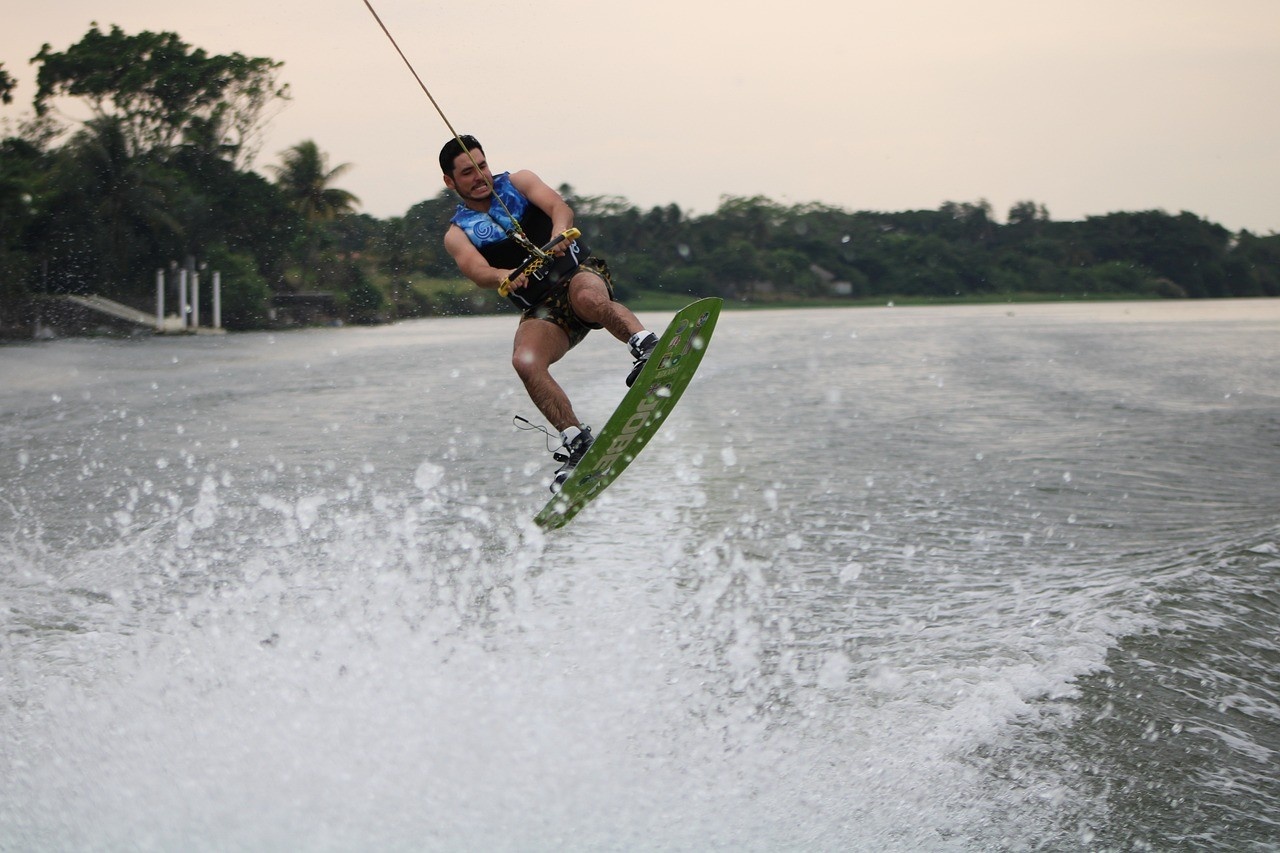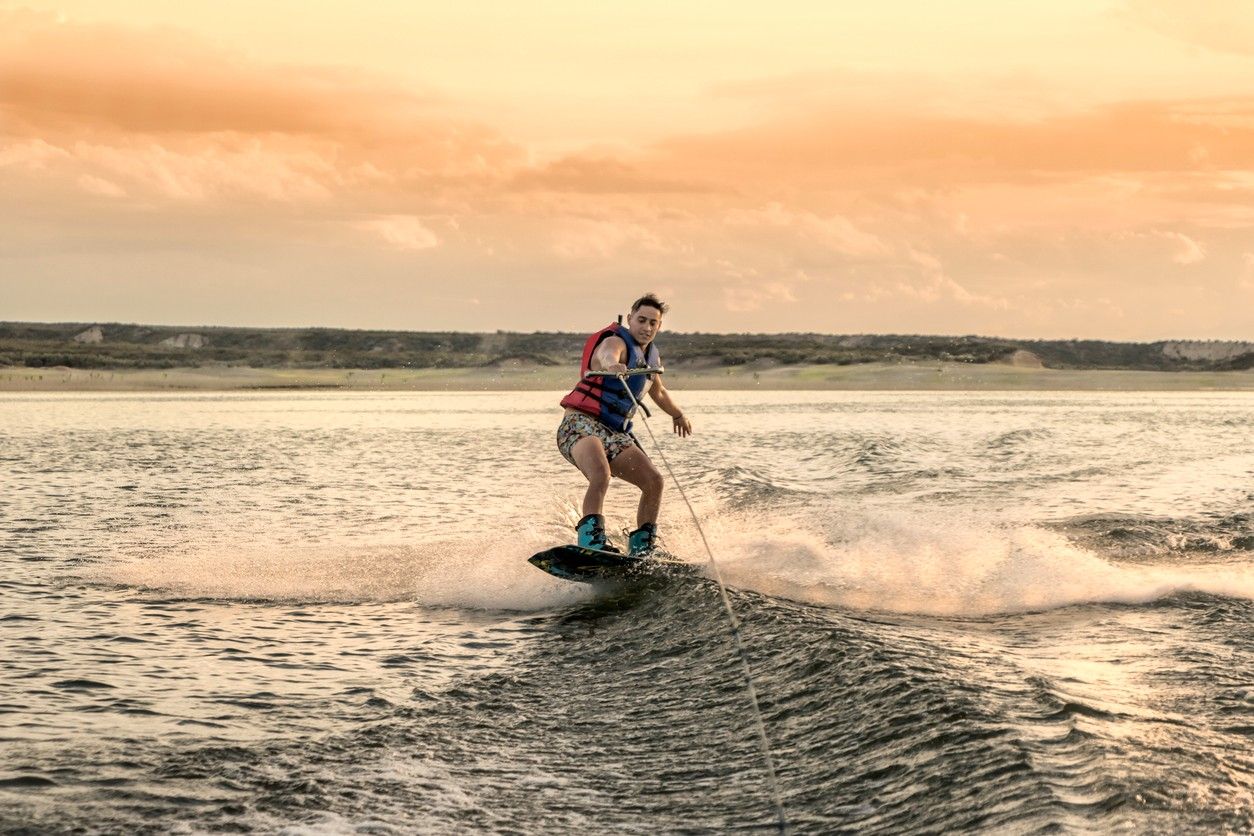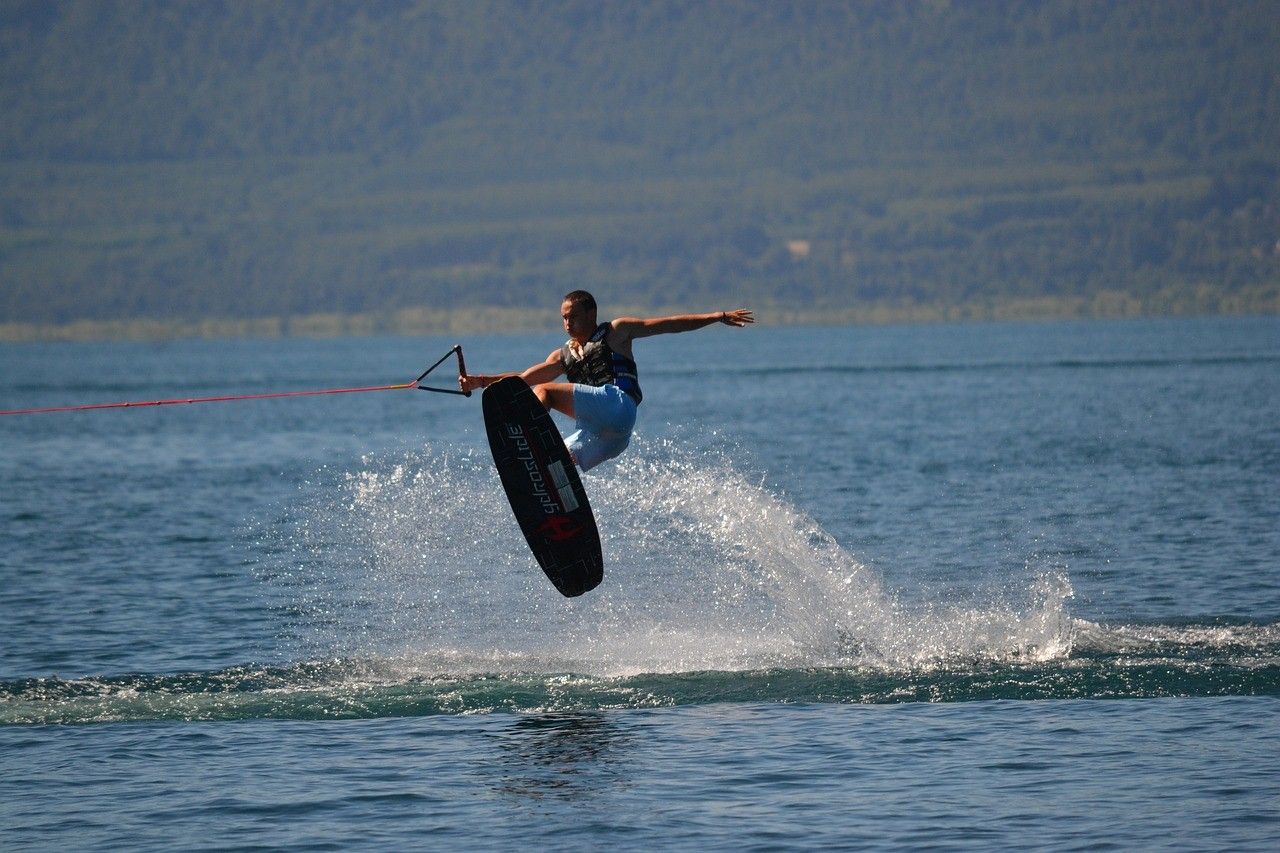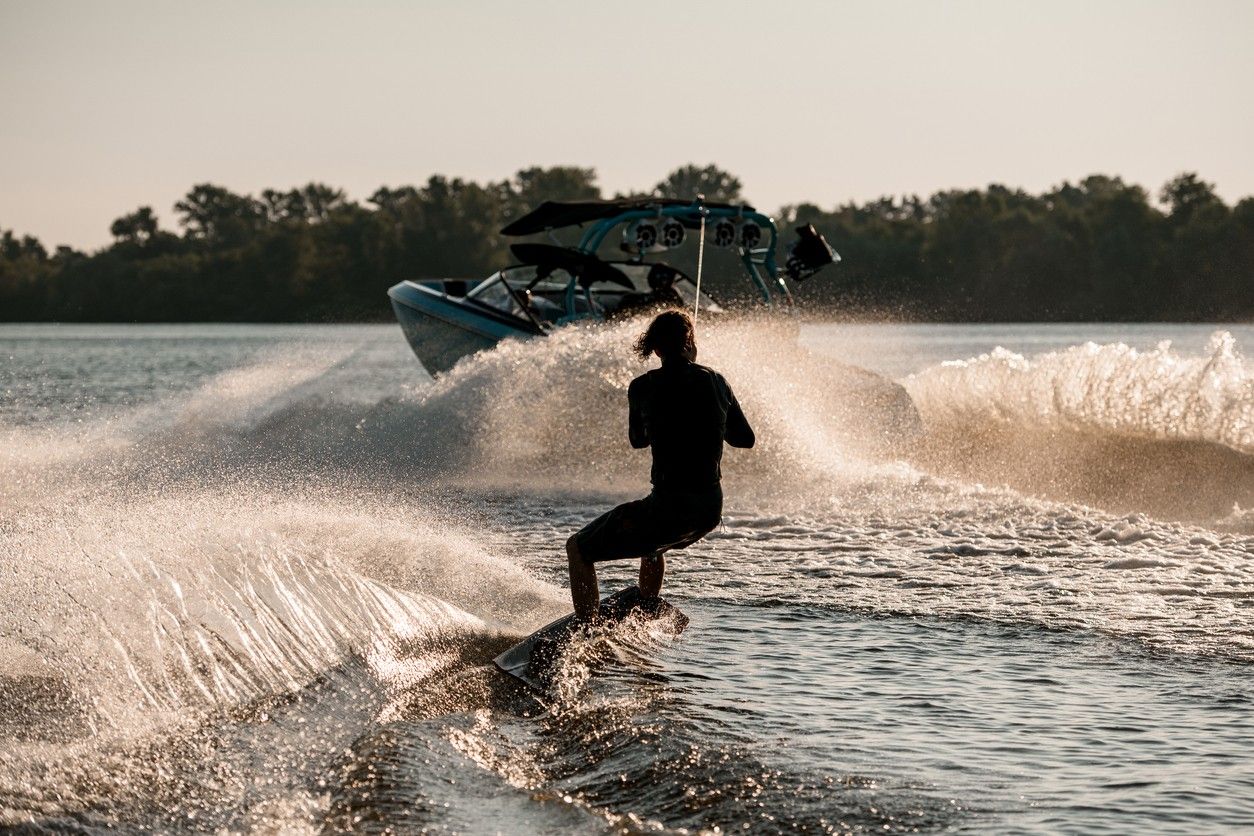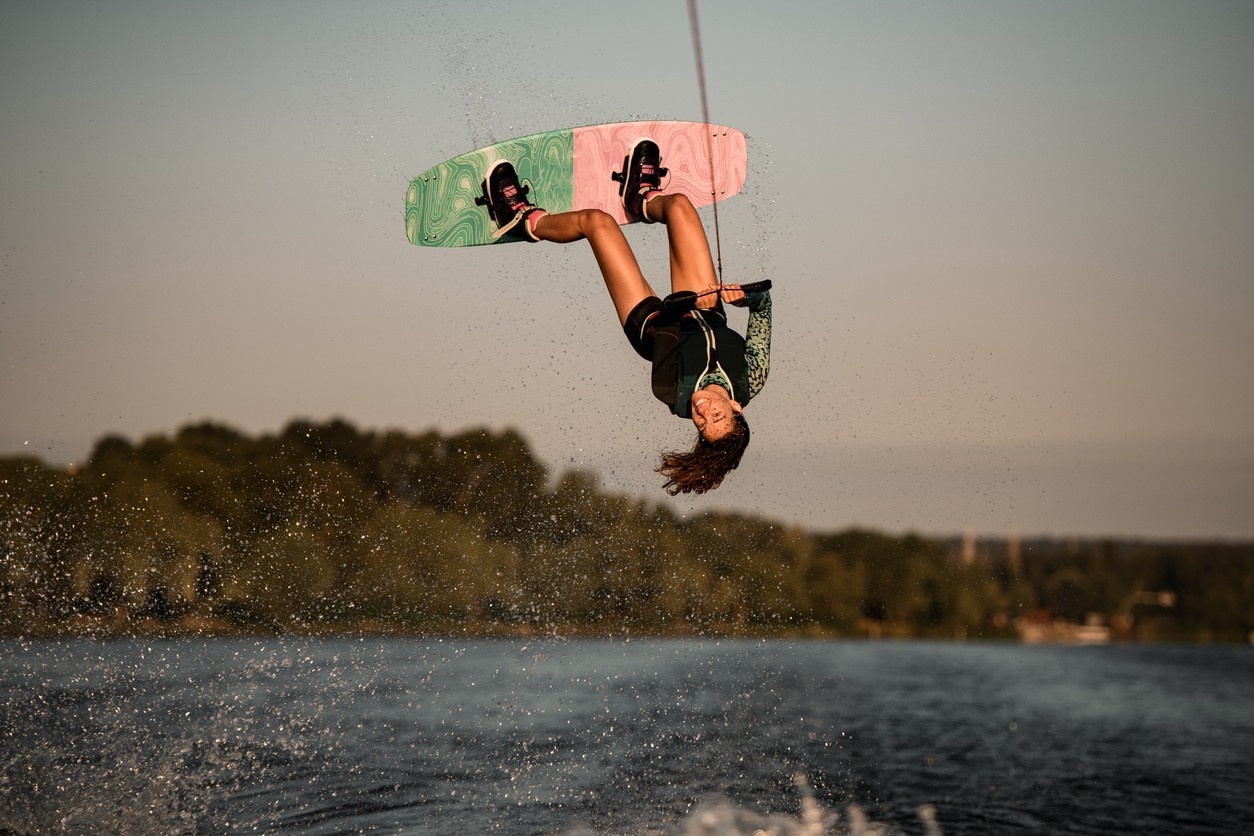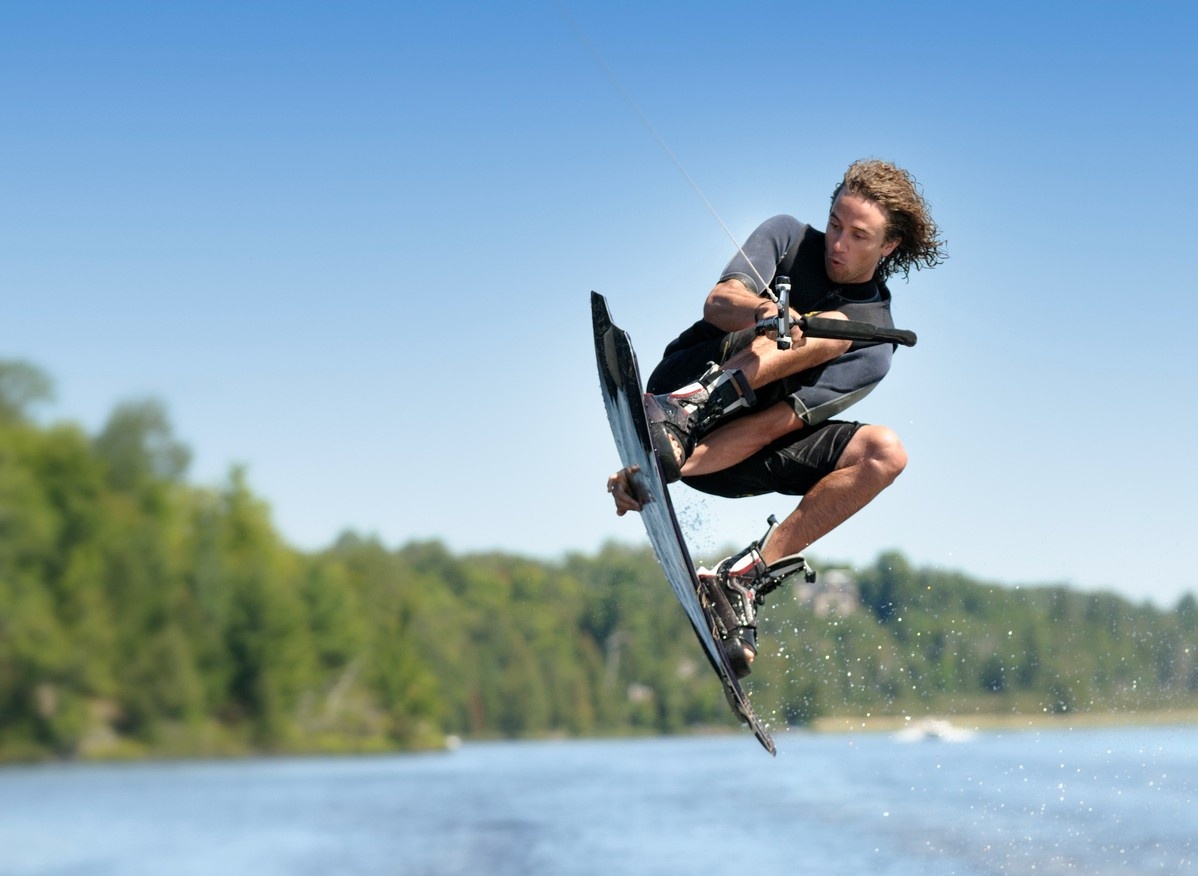Wakeboarding is a water sport that blends aspects of surfing, snowboarding, and waterskiing into one adrenaline-pumping activity. The wakeboard itself is at the heart of wakeboarding, a small rectangular board equipped with foot bindings that allow riders to attach themselves to the board securely. Wakeboarders are pulled across the surface of a body of water by a boat or cable system, typically reaching speeds of around 30-40 km/h. As the boat or cable system moves forward, it creates a wake, which is a series of waves that trail behind the vessel. Wakeboarders use this wake as a launching pad to perform aerial tricks and maneuvers, showcasing their skills and creativity on the water.
Wakeboarding has its roots in the water sports boom of the 1980s. Surfers and waterskiers were looking for new ways to enjoy the water and experimented with riding boards behind boats. The first wakeboards were simple affairs, often cobbled together from surfboard blanks and waterskis. As the sport gained popularity, dedicated wakeboard companies started to emerge, producing purpose-built boards and bindings. The introduction of compression-molded boards in the early 1990s was a breakthrough, allowing for lighter, stronger and more responsive designs. Throughout the 90s and 2000s, wakeboarding continued to evolve and grow. New tricks and riding styles emerged, pushed by a new generation of talented riders. The introduction of wakeboard parks and cable systems made the sport more accessible than ever, and competitions like the X Games helped bring wakeboarding to a mainstream audience.
Wakeboarding has grown rapidly in popularity since it first emerged in the 1980s. It appeals to people of all ages and skill levels, from beginners looking for a fun way to enjoy the water to professional athletes pushing the boundaries of what's possible. One of the great things about wakeboarding is its accessibility. Unlike some other water sports that require lots of expensive equipment and specialised knowledge, wakeboarding is relatively simple to get started with. Most wakeboard parks and schools provide all the gear you need, including wakeboards, bindings, helmets and life jackets. They'll also give you expert instruction to help you get up on the board and start riding safely. As you progress, you'll have the opportunity to learn a huge range of tricks and techniques. From simple jumps and grabs to complex flips and spins, the possibilities are endless. You can ride recreationally with friends and family, challenge yourself to learn new skills, or even enter competitions and push your riding to the elite level.
The Equipment You Need to Start Wakeboarding
If you're keen to give wakeboarding a try, the first step is getting your hands on the right equipment. While it's possible to buy your gear, most beginners start by renting equipment from a wakeboard park or school. This gives you a chance to try out the sport without making a big financial investment upfront.
Wakeboards
The most important piece of wakeboarding equipment is, of course, the wakeboard itself. Wakeboards come in a variety of shapes and sizes to suit different riding styles and skill levels. Beginners will usually start on a larger, more buoyant board that's easier to balance on. As you progress, you may want to move to a smaller, lighter board for more manoeuvrability and pop off the wake. When choosing a wakeboard, consider factors like your height, weight, and riding style. A good rule of thumb is to choose a board that comes up to somewhere between your chin and nose when standing on end. Beginners will want a board with a continuous rocker (curve) for a smooth, stable ride, while more advanced riders may prefer a three-stage rocker for more explosive pop.
There are several different types of wakeboards designed for specific riding styles and activities:
Boat Wakeboards — These boards are designed for riding behind a boat. They are stiffer and less flexible to provide more pop off the wake and better control on landings. Boat wakeboards usually have fins (either moulded or removable) and features on the base to help with edging.
Cable Park Wakeboards — Made for riding at cable parks, these boards have more flex, featureless bases, and removable or no fins. The flexibility and lack of fins make it easier to perform tricks on obstacles like rails and kickers at cable parks.
Hybrid/Crossover Wakeboards — These versatile boards combine features of both boat and cable park wakeboards. They have medium flex (softer at the tips, stiffer between the bindings), simple base designs, and removable fins to accommodate both riding styles.
Wake Surfboards — Designed for wake surfing, where the rider surfs the boat's wake without being directly pulled. Wake surfboards are thicker and have more volume than standard wakeboards to allow for surfing without bindings.
Wakeskates — Similar to wakeboards but without bindings. The rider's feet are not attached to the board, allowing for more freedom and skateboard-style tricks.
Additionally, wakeboards come in different lengths, rocker types (continuous, 3-stage, 5-stage, hybrid), flex patterns, and base shapes to suit various skill levels and riding preferences.
Wakeboard Lengths:
Up to 120 cm — Suitable for riders weighing less than 70 lbs.
115-120 cm — Ideal for riders weighing between 50-90 lbs.
120-130 cm — Recommended for riders weighing 65-110 lbs.
131-134 cm — Suitable for riders weighing 90-120 lbs.
135-138 cm — Ideal for riders weighing 110-155 lbs.
139-141 cm — Recommended for riders weighing 130-170 lbs.
142-144 cm — Suitable for riders weighing 150-200 lbs.
145-146 cm — Ideal for riders weighing 170-225 lbs.
146-150 cm+ — Recommended for riders weighing 225 lbs or more.
Rocker Types:
Continuous Rocker:
- One fluid, curved shape from tip to tail.
- 3-Stage Rocker:
- Features three distinct planes on the bottom of the board.
- Offers more explosive pop off the wake compared to a continuous rocker.
- Provides a looser, slippery feel on the water surface.
- Slower than a continuous rocker as the board ploughs rather than cuts through the water.
- A flatter centre spot results in more intense landings and a slightly sluggish feel after landing.
Hybrid Rocker (also known as Hybrid 3-Stage, Abrupt Continuous, or Blended 3-Stage):
- A combination of continuous and 3-stage rocker characteristics.
- Each brand offers a different combination of features from both rocker types.
- Provides fast, smooth rides and easier linking of turns.
- Allows for high speed and predictable pop off the wake.
- Great for carving, especially on flat, glassy water.
It's important to note that the ideal wakeboard length depends on the rider's weight and skill level, while the choice of rocker type is influenced by the desired riding style and personal preferences. Beginners often prefer longer boards with continuous rockers for stability and speed, while advanced riders may opt for shorter boards with 3-stage or hybrid rockers for explosive pop and aggressive riding.
Bindings
Wakeboard bindings are an essential component of the wakeboarding setup, as they securely attach the rider's feet to the board, providing control, stability, and the ability to perform various tricks and maneuvers. Bindings come in a variety of styles, sizes, and flex ratings to accommodate different rider preferences and skill levels. One important aspect to consider when choosing wakeboard bindings is the closure system. There are two main types of closure systems: lace-up and velcro. Lace-up bindings offer a more customisable and secure fit, allowing riders to adjust the tightness across the entire foot. This type of binding is often preferred by advanced riders who demand precise control and responsiveness. On the other hand, velcro bindings are easier to put on and take off, making them a popular choice for beginners and those who prioritise convenience.
Another factor to consider is the flex rating of the bindings. Flex refers to the amount of give or flexibility the bindings have when pressure is applied. Softer flex bindings are more forgiving and comfortable, making them ideal for beginners and those who enjoy a more relaxed riding style. Stiffer flex bindings, on the other hand, offer greater responsiveness and energy transfer, allowing for more aggressive riding and advanced tricks. Many bindings feature a medium flex, which provides a balance between comfort and performance, suitable for a wide range of riders and skill levels. Wakeboard bindings also come in various sizes to ensure a proper fit for different foot sizes. It is crucial to choose bindings that fit snugly and securely without causing discomfort or restricting circulation. Many brands offer size charts to help riders determine the appropriate binding size based on their shoe size.
In addition to the closure system, flex rating, and size, wakeboard bindings also feature different levels of support and cushioning. Higher-end bindings often incorporate advanced materials and technologies to provide enhanced shock absorption, impact protection, and overall comfort. This can include features such as EVA foam liners, 3D-molded footbeds, and adjustable heel and toe supports. When selecting wakeboard bindings, it is important to consider the compatibility with the wakeboard itself. Some bindings are designed to work with specific mounting systems or board shapes, so it is essential to ensure that the bindings are compatible with the chosen wakeboard.
Proper maintenance and care of wakeboard bindings are also crucial to ensure longevity and optimal performance. This includes regularly inspecting the bindings for signs of wear or damage, cleaning them after each use, and storing them in a dry, cool place when not in use. Investing in a quality pair of wakeboard bindings that suit the rider's skill level, riding style, and preferences can greatly enhance the overall wakeboarding experience. The right bindings provide the necessary support, control, and comfort to allow riders to progress their skills and enjoy the sport to the fullest.
Safety Gear
Safety equipment is also a must when wakeboarding:
Helmet — An indispensable piece of safety equipment to protect the head from impacts and potential injuries. Choose a high-quality, well-constructed, and comfortable wakeboard helmet with a tough outer shell and dense inside layer. Various styles are available to match personal preferences.
Life Jacket or Buoyancy Aid — Essential for keeping the rider afloat in case of falling off the wakeboard. Minimises the risk of getting stuck under the water or waves. Wakeboard-specific life jackets are designed for mobility, made from stretchy neoprene material, and fit snugly to allow for nimble movement.
Impact Vest — Protects the rider from impacts on the water surface, especially during falls or crashes. Provides additional cushioning and support to the upper body.
Wetsuit — Essential for maintaining body temperature in cold water conditions. Available in various thicknesses (2mm-5mm) and styles (sleeveless, short-sleeved, short legs, long-sleeved) to suit different weather conditions. Neoprene material traps a thin layer of water between the skin and the suit, which is heated by the body to provide insulation.
Neoprene Gloves (for winter wakeboarding) — Keeps hands dry and warm in cold conditions.
Knee Braces and Back Supports — Provide additional protection and support for the knees and back, especially when riding at cable parks.
Wakeboard Mirrors (for the boat) — Allow the boat driver to see the rider at all times, ensuring better safety and awareness. Adjustable mirrors can be attached to the boat's wakeboard tower or windshield.
While not strictly safety gear, beginners should also focus on wearing comfortable clothing that allows for easy movements, such as one-piece suits or two-piece outfits, depending on personal preference.
Learning the Basics of Wakeboarding
Once you've got your equipment sorted, it's time to hit the water and start learning the basics of wakeboarding. If you're new to the sport, it's highly recommended to take a lesson from a qualified instructor. They'll be able to teach you proper technique, and safety considerations, and help you progress more quickly than trying to learn on your own.
Getting Up on the Board — The first thing you'll need to master is getting up on the wakeboard. Start by floating in the water with your knees bent and the board in front of you. As the boat or cable starts to pull you forward, let the board come underneath your feet and stand up slowly, keeping your knees bent and your weight centred over the board. It may take a few tries to get the hang of it, but once you're up, try to maintain a relaxed, athletic stance with your knees and ankles slightly bent. Keep your arms relaxed and your head up, looking in the direction you want to go.
Turning and Edge Control — Once you're comfortable standing on the wakeboard, the next step is to learn how to turn and control your edges. To initiate a turn, shift your weight onto your heels or toes to engage the corresponding edge of the board. For a heelside turn, lean back and press your heels down, causing the board to tilt and carve in that direction. For a toeside turn, lean forward and press your toes down, allowing the board to pivot in the opposite direction. Keep your arms relaxed and your head up, looking in the direction you want to go. Practice making smooth, controlled turns in both directions, gradually increasing the pressure on your edges as you gain confidence.
Crossing the Wake — Crossing the wake is an essential skill that allows riders to transition from one side of the boat's wake to the other. To cross the wake, approach it at a slight angle, using your edges to maintain speed and control. As you reach the crest of the wake, shift your weight to your front foot and allow the board to launch off the top of the wake. Keep your knees bent and your body compact as you cross the wake, absorbing any bumps or chop in the water. As you land on the other side, use your edges to regain control and continue riding. Practice crossing the wake in both directions, focusing on maintaining a smooth, controlled motion throughout the manoeuvre.
Progressing to Tricks — Once you've mastered the fundamentals of wakeboarding, you can start exploring more advanced tricks and techniques. Begin by learning basic air tricks, such as jumps and grabs. To perform a jump, approach the wake with speed and pop off the top using your legs and core. Grab the board with your hand to add style and control. As you land, bend your knees to absorb the impact and ride away smoothly. Progress to more complex tricks like 180s, 360s, and inverts by combining rotations, grabs and flips. Remember to start small and build up gradually, focusing on proper technique and body position. Always prioritise safety and ride within your limits, using protective gear and seeking guidance from experienced riders or instructors.
Wakeboarding Tricks
Wakeboarding tricks are the heart of the sport, allowing riders to express their creativity, style, and skill on the water. As riders progress from beginner to advanced levels, they can learn and combine a variety of tricks to create their unique riding style. Wakeboarding tricks can be categorised into several main groups, each with its own set of fundamental manoeuvres and variations.
Surface Tricks
Surface tricks are performed on the water's surface without leaving the wake. These tricks are often the foundation for more advanced manoeuvres and are essential for building board control and confidence.
Frontside/Backside Slalom turn (outside the wake)
Frontside/Backside Off the Wake
Lipside (boardslide on the lip of the wake)
Powerslide (turning the board backside 90, facing away from the line, sliding along the water)
Ollie (a jump where the board leaves the water.
Grabs
Grabs involve the rider reaching down and holding onto the wakeboard while in the air. These tricks add style and complexity to jumps and can be combined with spins and flips for even more advanced manoeuvres.
Indy (backhand between the feet, toeside edge)
Tindy (backhand, toeside edge between back foot and the tail of the board)
Tail (backhand, grab the tail edge of the board)
Tailfish (backhand, heelside edge between the back binding and the tail)
Stalefish (backhand, heelside edge between the bindings)
Spins
Spins involve the rider rotating their body and board while in the air. These tricks can be performed frontside (rotating towards the boat) or backside (rotating away from the boat) and can range from simple 180s to more complex 720s and beyond.
Frontside (FS) spin (first 90 degrees facing towards the line)
Backside (BS) spin (first 90 degrees facing away from the line)
Flatline (180, 360, 720) (rider rotates their board over the rope rather than passing the handle)
Orbital (backside 360, rider goes off-axis and swings their board over the rope)
Inverts (Flips)
Inverts, or flips, involve the rider rotating their body and board vertically while in the air. These tricks can be performed frontside or backside and can be combined with spins and grabs for even more advanced variations.
Front Flip (heelside approach, rider flips tail over nose)
Front Roll (toeside front roll, board rotating heel over toe)
Back Roll (heelside release, the board rotates nose over tail)
Tantrum (toeside backflip)
Whip (heelside backflip releasing from the water off the toeside rail)
Raley-Based Tricks
Raley-based tricks involve the rider extending their body and board out behind them in a "Superman" position. These tricks can be combined with grabs, spins, and handle passes for more advanced variations.
Raley (rider's board is thrown out behind them in a "Superman" fashion)
Hoochie Glide (a Raley with a Method grab)
S-Bend (a Raley with an overhead backside 360)
Krypt (a Raley with a frontside 180)
Handle Pass Inverts
Handle pass inverts combine flips and spins with the rider passing the handle behind their back during the trick. These are some of the most advanced and technical tricks in wakeboarding.
Front Blind Mobe (a heelside front flip with a backside 360)
Slim Chance (a front flip with a frontside handle pass 360)
Moby Dick (a tantrum with a backside handle pass 360)
KGB (a back roll with a backside 360 handle pass)
Combination Tricks
Combination tricks involve linking multiple manoeuvres together in a single fluid motion. These tricks allow riders to showcase their creativity and style by combining elements from different trick categories.
Front-to-Blind (a heelside front flip with a backside 180)
Roll-to-Revert (a heelside backroll with a frontside 180)
Roll-to-Blind (a heelside backroll with a backside 180)
Pete Rose (a toeside backroll with a frontside 360)
G-Spot (a toeside backroll to blind)
Finding Places to Go Wakeboarding
Now that you've got the basics down, you're probably eager to get out on the water and practice your new skills. Fortunately, there are plenty of great places to go wakeboarding all around the UK.
Cable Parks
If you're looking for a dedicated wakeboarding facility, cable parks are a great option. These parks feature a network of overhead cables that tow riders around a lake or pond, eliminating the need for a boat. Cable parks often have obstacles like ramps and sliders for riders to practice tricks on, and many offer lessons and camps for all skill levels.
Some popular cable parks in the UK include:
Foxlake Adventures in Dunbar, Scotland
WakeMK at Willen Lake in Milton Keynes
Lakelands Cable Park in Mepal, Cambridgeshire
Rother Valley Country Park in Sheffield
Quayside Wake & Ski in Mytchett, Surrey
Boat Wakeboarding
If you prefer the classic experience of riding behind a boat, there are also plenty of opportunities for boat-based wakeboarding around the country. Many watersports centres and schools offer wakeboard lessons and sessions using their boats and equipment. You can also join a wakeboard club or group to connect with other riders and share the cost of boat hire.
Some top spots for boat wakeboarding in the UK include:
Loch Lomond in Scotland
Bewl Water in Kent
Tattershall Lakes in Lincolnshire
Llyn Tegid (Bala Lake) in Wales
Hannam's Wake Hub in Dorset
Wakeboarding in London
For those living in or visiting London, there are also several options for wakeboarding within easy reach of the city. Liquid Leisure in Windsor is a popular cable park just a short train ride from central London, while Wake Up Docklands offers boat wakeboarding sessions in the heart of the city at Royal Victoria Dock. No matter where you live or travel in the UK, a quick online search for "wakeboarding near me" is sure to turn up some promising options. Don't be afraid to reach out to local watersports centres, schools or clubs - most will be more than happy to welcome a new rider and help you get started in this exciting sport.
Progressing Your Wakeboarding Skills
As you spend more time on the water and your skills improve, you'll naturally want to start pushing yourself to try new and more challenging things. This is one of the most rewarding aspects of the sport - there's always something new to learn and master.
Getting More Air — One of the first things many riders want to work on is getting more air off the wake. To boost your jumps, focus on using your edges to build speed and pop off the top of the wake. As you launch into the air, bring your knees up towards your chest and keep your head and shoulders up and back.
Experiment with different body positions and grabs to add style to your airs. As you advance, you can start working on spins and flips for even more impressive moves.
Riding Switch — Another fun skill to learn is riding a switch or with your non-dominant foot forward. This opens up a whole new range of trick possibilities and can help improve your overall board control. Start by practising switch straight airs and basic grabs, then work your way up to more complex manoeuvres like 180s and 360s.
Hitting Obstacles — As you advance in wakeboarding, you may also want to start riding obstacles like sliders, kickers and rails. These features are common at cable parks and provide a fun way to change up your riding and learn new tricks. Start with simple slide boxes and pipes, focusing on maintaining a low, stable body position as you ride on. As you get more comfortable, you can progress to more challenging obstacles like incline rails and gap kickers.
Wakeboard Competitions
If you're really looking to take your riding to the next level, consider entering some wakeboard competitions. These events are held at cable parks and lakes all around the UK and provide a great opportunity to showcase your skills, meet other passionate riders and push your progression.
There are categories for all age groups and skill levels, from first-timers to seasoned pros. Some of the biggest wakeboard competitions in the UK include:
The UK Wake Nationals
The Plastic Playground Series
The Grassroots Tour
The Cable & Wake Boat Jam
Wakeboarding is a thrilling and rewarding water sport that offers something for everyone. Whether you're a complete beginner looking for a new way to enjoy the outdoors or an experienced rider seeking to push your skills to the next level, wakeboarding has it all. With the right equipment, instruction and mindset, anyone can learn to wakeboard and experience the rush of riding across the water and launching off the wake. And with a growing network of cable parks, boat schools and clubs across the UK, it's never been easier to get involved in this exciting sport. So what are you waiting for? Grab a board, hit the water and discover the joy of wakeboarding for yourself. You won't regret it!
Related articles

Let us know you agree to cookies
We use marketing, analytical and functional cookies as well as similar technologies to give you the best experience. Third parties, including social media platforms, often place tracking cookies on our site to show you personalised adverts outside of our website.
We store your cookie preferences for two years and you can edit your preferences via ‘manage cookies’ or through the cookie policy at the bottom of every page. For more information, please see our cookie policy.
